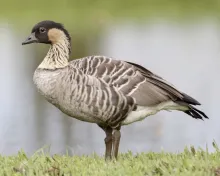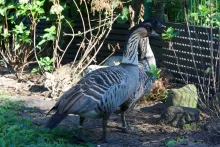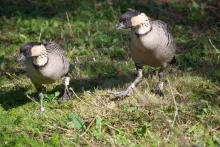
Nene Hawaiian goose (Branta sandvicensis)
Species name
- Dutch name:
- Hawaiigans
- English name:
- Nene Hawaiian goose
- German name:
- Hawaiigans
- French name:
- Bernache néné
- Scientific name:
- Branta sandvicensis
Scientific classification
- Order:
- Anseriformes
- Family:
- Anatidae
- Onderfamilie:
- Anserinae
- Genus:
- Branta
Description
- Description:
Male:
The male has a black head and hindneck, buff cheeks and heavily furrowed neck The neck has black and white diagonal stripes. Undderparts ; from base of neck to just past legs light brown with creamy barring vent to under tail converts white . tail black with inner converts white. Upperparts; sides are dark brown with Thin creamy barring ,Wings are Dark Brown with creamy barring primaries are dark Brown. Bill, legs and feet are black.Female:
Identical to male but 11% smaller best if compared wile paired.Juvenile:
Are a duller brown and with less demarcation between the colors of the head and neck, and striping and barring effects are much reduced
Standard Measurements
- Body Length (cm):
- The male (drake) of the Nene Hawaiian goose measures approximately 56-71 centimeters. The female measures approximately 56-71 centimeters.
- Body Weight (grams):
- The male will weight about 1920-2215 gram. The female will weight about 1920-2215 gram.
The weight is notoriously variable and can only be used as indication!
- Note:
Nenes are generally hardy and not difficult to keep, but somewhat cold-sensitive, prone to frost-bitten feet; they should be provided with thick straw and a shelter may be required depending on climate. Large areas of grazing preferred. These geese are generally tame and confiding - some ganders may be aggressive during the breeding season. Grazing should be supplemented with floating pellet feed, particularly in winter.
Pairs mate for life and engage in relatively simple courtship displays in which the male attacks or threatens potential competitors, runs back to his mate, and calls loudly. These geese are fairly easy to breed. Use natural ground cover (close or open) for breeding. May lay in February to end of March (they frequently re-lay if the clutch is removed). May be parent-reared.
This species rarely hybridises: a single case of breeding with Swan goose (Anser cygnoides) has been reported.
- Breeding:
- The female Nene Hawaiian goose usually lays from 3-5 white eggs and incubates them for 29-31 days.
- Artificial incubating:
The ideal relative humidity for incubating most waterfowl eggs is 55% (ground nesters) and 40% (cavity nesters). The temperature is usually 37.4°C. Set ventilation as recommended by the incubator manufacturer. Eggs must be turned, either automatically or by hand, a minimum of 4 times a day. As the duckling develops there is a loss of water from the egg and the air sac gets bigger. In normal development of an egg with a 29-31 days incubation, the air sac occupies about a third of it three days earlier. Cleanliness is vital and ideally eggs should be moved to a separate hatcher at this point, where the humidity should be increased to 65% and even higher once they have pipped internally.
- Bird banding:
- Recommended closed leg band ring size for the Nene Hawaiian goose is 16 mm.The leg band ring can only be applied on a young goose at around 14 days old.
- It doesn't matter what leg that you band, but it's good to have a consistent system. Suggested: Left leg = Female, Right leg = Male
- Maintenance food:
-



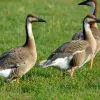

Lundi Regular with a protein content of 20%, valuable Spirulina and high-quality by-products is optimally balanced in its composition maintenance food for water ornamental fowl of all kinds. Especially green teal and Whistling ducks that are not dependent on a very high protein content, are well supplied.
Lundi Regular contains all the minerals and vitamins in full form that are important for the animals. Therefore also suitable as breeding food.


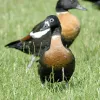


Floating full food for all sea ducks, green ducks, eider ducks and geese, especially in the moulting and breeding phase ideally suited. Packed with wholesome raw materials, natural vitamins and trace elements, this performance food with a protein content of 30% forms the basis for lifelong vitality.
- Regulation:
- Vrijstelling CITES, bijlage X
- Regulation:
Bird species included in Appendix X to the Implementing Regulation are bird species included in Appendix A to the Basic Regulation, but many are bred in captivity that there are virtually no wild specimens traded. The legislation on this is currently not uniform and therefore we cannot give you any advice on this. We are in talks with the government to clarify this. Here too the advice applies: Always ring your young birds with the correct leg ring. If you buy birds of this species without a leg ring, always ask the seller for an origin or waiver.
